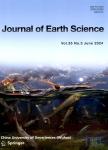Palaeoecological Analysis of Trace Fossil Sinusichnus sinuosus from the Middle Triassic Guanling Formationin Southwestern China
Palaeoecological Analysis of Trace Fossil Sinusichnus sinuosus from the Middle Triassic Guanling Formation in Southwestern China作者机构:School of Life and Environmental Sciences (Melbourne Burwood Campus) Deakin University Burwood VIC 3125 Australia State Key Laboratory of Biogeology and Environmental Geology China University of Geosciences Wuhan 430074 China Chengdu Center of China Geological Survey Chengdu 610081 China
出 版 物:《Journal of Earth Science》 (地球科学学刊(英文版))
年 卷 期:2018年第29卷第4期
页 面:854-863页
核心收录:
学科分类:070903[理学-古生物学与地层学(含:古人类学)] 0709[理学-地质学] 07[理学] 0708[理学-地球物理学] 0704[理学-天文学]
基 金:partly supported by the ARCDP discoverygrant to G. R. Shi (No. DP150100690) supported by a CAS Pioneer Hundred Talents Program (to ML) supported by a grant from the State Key Laboratory of Biogeology and Environmental Biology (No. GBL21410 to ML), China University of Geosciences (Wuhan) a grant from the National Natural Science Foundation of China (No. 41502013) supported by for China Geological Survey projects (Nos. DD20160020, 1212011140051, 12120114030601, and 1212010610211)
主 题:Sinusichnus sinuosus decapod crustacean trace fossil Middle Triassic Luoping southwestern China
摘 要:The Luoping Biota discovered from the early Middle Triassic (Anisian) Guanling Formation of southwestern China represents a fully recovered shallow marine ecosystem, marking the end point of Early Triassic biotic recovery following the end-Permian mass extinction. Contemporaneously preserved are prolific trace fossils, which offer good opportunities to understand the palaeoecology of marine invertebrates from a fully recovered shallow marine ecosystem. Here we present a newly discovered sinuous branching burrow from the fossil-bearing unit in Member II of the Guanling Formation. Several features, including the horizontal regular sinuous nature, the branching pattern, typical H-junction, and the small wavelength/amplitude ratio of these sinuous structures within the burrow systems justify assignment of these traces as Sinusichnus sinuosus, a trace possibly produced by decapod crustaceans. Close association ofS. sinuosus with Rhizocorallium commune suggests a deposit-feeding strategy of these trace makers. The newly reported Anisian material from the Guanling Formation in Luoping represents first report of Sinusichnus from South China. The global record of Sinusichnus occurrence suggests that these burrows might have an older history than Early Middle Triassic.



